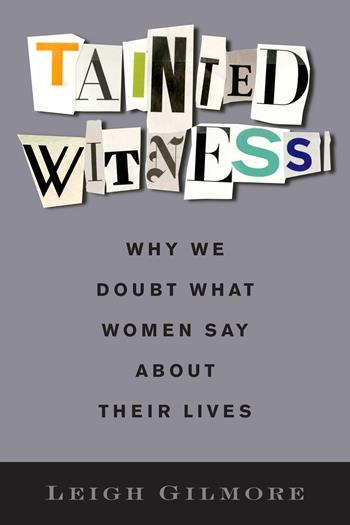Gender, Race, and Credibility in the Age of Trump

This narrative of individual healing, effort, and ultimate success is available primarily to white women, who have historically been constructed as precious and thus worthy of protection from hard manual labor, economic discomfort, and sexual violation (however ineffective that narrative may have been at protecting them from actual exploitation and harm at the hands of the white men who frequently controlled their bodies, finances, and lives). No comparable narrative of protection and worth attaches to women of color, who have historically been and continue to be depicted in ways eminently convenient for those who wish to exploit them: as built for the burdens of physical work; as hypersexual, even promiscuous; and as mendacious. She wanted it—and if she said she didn’t, she was lying.
Today, we are pleased to present you with an excerpt from a thought-provoking book review by Joy Castro of Tainted Witness: Why We Doubt What Women Say About Their Lives, by Leigh Gilmore. This review originally appeared in The Women’s Review of Books.
• • • • • •
Currently distinguished visiting professor of Women’s and Gender Studies at Wellesley College, Gilmore has been breaking ground in the intersection of gender and life-writing for decades in Autobiographics: A Feminist Theory of Women’s Autobiography (1994) and The Limits of Autobiography: Trauma and Testimony (2001), as well as in numerous scholarly articles. In her new interdisciplinary project Tainted Witness, Gilmore expands on her previous work, mobilizing methodologies from multiple fields to analyze the legal response to and public reception of “women’s testimony and life narratives about sexual harassment or political violence” and to ask why such accounts are met with doubt. On the heels of the 2016 presidential election, in which a self-confessed sexual assaulter without a professional background in politics defeated a highly competent woman with decades of relevant experience, and after last year’s spectacle when Bill Cosby walked free from a courtroom after more than fifty women had accused him of sexual assault, and in the midst of a moment when droves of women have accused Hollywood gatekeeper Harvey Weinstein of egregious sexual harassment, Gilmore’s question could not be more timely. Her answers are all about power.
Cogent, thorough, methodical, and graceful, Tainted Witness is a model of clear, effective, and sociopolitically important scholarship. Gilmore’s case studies are drawn from interestingly varied spheres, from politics to literature to public scandal. She tracks the tribulations and achievements of Anita Hill, who testified before the Senate about sexual harassment during Clarence Thomas’s confirmation hearings in 1991; 1992 Nobel Peace Prize winner Rigoberta Menchú, whose memoir about political violence in Guatemala has been variously contested and vindicated; Nafissatou Diallo, the Guinean immigrant and housekeeper who was raped by former International Monetary Fund director Dominique Strauss-Kahn; and the three women who co-founded the Black Lives Matter movement. In addition, she analyzes the literary work of Kathryn Harrison, Jamaica Kincaid, and Claudia Rankine to assert conclusively that when women tell their stories of bodily damage, they are widely disbelieved.
Doubt attends their narratives in the form of two skeptical counternarratives that are almost inevitably deployed in the wake of accusations of (particularly sexual) violence: “he said/she said,” and “nobody really knows what happened.” Both function a priori to “render as unknowable and undecidable both physical evidence and verbal testimony.” In the courtroom and the media, women who testify to violence at the hands of powerful men are unlikely to receive a fair hearing. In contrast, women who turn to the medium of life-writing (whether in memoir or in autobiographical fiction), to present complex accounts of damage (sexual, physical, political, economic) may have a stronger chance of finding an “adequate witness”—over time, at least. Their testimony—even if contested and critiqued—can continue to circulate until it reaches an audience capable of receiving it.
The “adequate witness,” in Gilmore’s formulation, does not root her response in empathy, which relies upon some degree of similarity to the testifying woman. The requirement that she be like us in some recognizable way—that we be able to identify with her, sympathize with her, even idealize her—obscures the ethical demand of listening those different from ourselves and insisting upon justice on their behalf. What happens, for example, to the validity of the testimony of the truth-teller deemed too old, too unlovely, or too morally imperfect to generate empathy in listeners? In contrast, “[a]n adequate witness is one who will receive testimony without deforming it by doubt, and without substituting different terms of value for the ones offered by the witness herself,” writes Gilmore. She “resists the rush to judgment and learns how to attend to accounts of gendered harm and agency made by impure victims in conditions of complexity.” Gilmore’s overall argument is a strong one, borne out by multiple and well-developed examples over the course of the book’s unfolding, and her prose is both complex and concise, a pleasure and an education to read.
Particularly interesting is her third chapter, “Neoliberal Life Narrative: From Testimony to Self-Help.” Here she examines the fortunes of bestselling memoirs by white women—Jeanette Walls’ The Glass Castle (2005), Elizabeth Gilbert’s Eat, Pray, Love (2006), and Cheryl Strayed’s Wild (2012)—all three of which became major motion pictures with Hollywood stars. The critical and marketplace reality is that not all women’s life-narratives are disbelieved and dismissed. Rather, some are embraced, quite profitably—as long as they conform to a narrative arc of personal empowerment within capitalism via the overcoming of obstacles (poverty, the dissolution of a relationship, the death of a parent), while eschewing “critical engagement with historic, systemic inequalities and violence that exceed the neoliberal focus on the individual.” Such narratives meet with both critical acclaim and commercial success.
“Neoliberal life narratives,” Gilmore explains, “do not impose an ethical demand on readers. They focus on one’s relation to one’s self rather than to others. They focus on what one person can do”—or rather, on what one relatively unencumbered, privileged person—however wounded—can do: hike, heal, dine, travel, fall in love. Individual redemption, not structural political change, is the culturally comfortable remedy that neoliberal life-narratives purvey. They echo the story the culture wants to tell itself about the possibilities for women: that problems are solvable with enough personal growth, resilience, optimism, grit, determination, and hard work. You can change your life. You can have everything you want (as long as you want the right things). Just Lean In.
This narrative of individual healing, effort, and ultimate success is available primarily to white women, who have historically been constructed as precious and thus worthy of protection from hard manual labor, economic discomfort, and sexual violation (however ineffective that narrative may have been at protecting them from actual exploitation and harm at the hands of the white men who frequently controlled their bodies, finances, and lives). No comparable narrative of protection and worth attaches to women of color, who have historically been and continue to be depicted in ways eminently convenient for those who wish to exploit them: as built for the burdens of physical work; as hypersexual, even promiscuous; and as mendacious. She wanted it—and if she said she didn’t, she was lying.
Narratives of the deprivation and suffering of girls and women of color are far more palatable to western readers, it seems, when those are filtered through the benevolent accounts of white western men who uplift and save them, as Gilmore demonstrates in a chapter on Nicholas Kristof and Greg Mortenson, the author of (the subsequently debunked) Three Cups of Tea (2009). Gilmore’s concluding chapter returns to accounts and actions by women of color, specifically African American women, including Opal Tometi, Alicia Garza, and Patrisse Cullors, the co-founders of the #BlackLivesMatter movement after the killing of Trayvon Martin in 2012; Sandra Bland, who died while in custody in Texas; Bree Newsome, who climbed a flagpole to remove the Confederate flag from the South Carolina statehouse after the mass shooting at the Emanuel African Methodist Episcopal Church in Charleston; and Claudia Rankine, whose brilliant mixed-genre autobiographical Citizen (2014) limns the multiple microaggressions that leave women of color feeling forever alien in their own land.
Read the entire review in The Women’s Review of Books.








